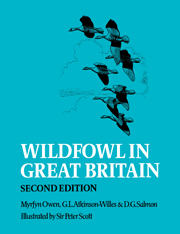Book contents
- Frontmatter
- Contents
- List of location maps
- Foreword by William Wilkinson
- Acknowledgements
- Conventions and abbreviations
- Part I Introduction
- Part II The survey of wildfowl habitat and distribution
- Part III Species accounts
- Introduction
- Principal species
- Other species
- Part IV The conservation of wildfowl and their habitats
- Conclusion
- References
- Indexes
Introduction
Published online by Cambridge University Press: 04 August 2010
- Frontmatter
- Contents
- List of location maps
- Foreword by William Wilkinson
- Acknowledgements
- Conventions and abbreviations
- Part I Introduction
- Part II The survey of wildfowl habitat and distribution
- Part III Species accounts
- Introduction
- Principal species
- Other species
- Part IV The conservation of wildfowl and their habitats
- Conclusion
- References
- Indexes
Summary
This part aims to summarise the available data on the numbers and distribution of each species of wildfowl in Britain. A brief description of the birds’ behaviour and feeding habits is given first since this is very relevant to the interpretation of their distribution. There are a total of 48 wildfowl on the British List (549, and later reports in The Ibis); most are predominantly winter visitors. Thirty-one species occur here commonly, and these are fully treated in the following accounts. The remainder are either sporadic in occurrence or are usually in small numbers; they are considered in less detail, at the end of the accounts. The British List includes four species introduced to Britain and now well established, although two, the Egyptian Goose and Mandarin Duck, are in relatively restricted areas. The Canada Goose, on the other hand, is very widespread in England and Wales. It, and the Ruddy Duck, continue to increase in numbers and to expand their range (406, see also p.460).
Wildfowl are widely kept in captivity and several other species have been seen in the wild in Britain from time to time although recognised as originating from captive stock. Among these are the Black Swan (Cygnus atratus), Bar-headed Goose (Anser indicus), Ross7 Goose (Anser rossi), Carolina or Wood Duck (Aix sponsa) and Ringed Teal (Calonetta leucophyrus). These are not likely to become widely established and recent legislation (p.539) makes further introductions more difficult.
- Type
- Chapter
- Information
- Wildfowl in Great Britain , pp. 336 - 344Publisher: Cambridge University PressPrint publication year: 1986



